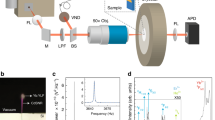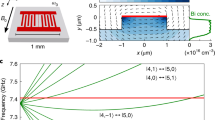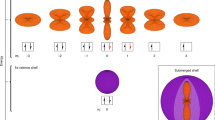Abstract
The idea of cooling a solid-state optical material by simply shining a laser beam onto it may seem counterintuitive, but this is rapidly becoming a promising technology for future cryocoolers. Here, we chart the evolution of the science of optical refrigeration in rare-earth-doped solids and semiconductors from its origins through to the present day.
This is a preview of subscription content, access via your institution
Access options
Subscribe to this journal
Receive 12 print issues and online access
$209.00 per year
only $17.42 per issue
Buy this article
- Purchase on Springer Link
- Instant access to full article PDF
Prices may be subject to local taxes which are calculated during checkout






Similar content being viewed by others
References
Chu, S., Cohen-Tannoudji, C. & Philips, W. D. For development of methods to cool and trap atoms with laser light. Nobel Prize in Physics (1997); <http://nobelprize.org>.
Cornell, E. A., Ketterle, W. & Weiman, C. E. For the achievement of Bose-Einstein condensation in dilute gases of alkali atoms, and for early fundamental studies of the properties of the condensates. Nobel Prize in Physics (2001); <http://nobelprize.org>.
Hänsch, T. W. & Schawlow, A. L. Opt. Commun. Cooling of gases with laser radiation. 13, 68–69 (1975).
Pringsheim, P. Zwei bemerkungen uber den Unterchied von luminneszenz- und temperaturstrahlung. Z. Phys. 57, 739–746 (1929).
Edwards, B. C., Buchwald, M. I. & Epstein, R. I. Development of the Los-Alamos solid-state optical refrigerator. Rev. Sci. Instrum. 69, 2050–2055 (1998).
Edwards, B. C., Anderson, J. E., Epstein, R. I., Mills, G. L. & Mord, A. J. Demonstration of a solid-state optical cooler: An approach to cryogenic refrigeration. J. Appl. Phys. 86, 6489–6493 (1999).
Mills, G. & Mord, A. Performance modeling of optical refrigerators. Cryogenics 46, 176–182 (2005).
Landau, L. On the thermodynamics of photoluminescence. J. Phys. (Moscow) 10, 503–506 (1946).
Kastler, A. Some suggestions concerning the production and detection by optical means of inequalities in populations of levels of spatial quantization in atoms. J. Phys. Radium 11, 255–265 (1950).
Kushida, T. & Geusic, J. E. Optical refrigeration in Nd-doped yttrium aluminum garnet. Phys. Rev. Lett. 21, 1172–1175 (1968).
Yatsiv, S. in Advances in Quantum Electronics (ed. Singer, J. R.) 200–213 (Columbia Univ. Press, New York, 1961).
Epstein, R. I., Buchwald, M. I., Edwards, B. C., Gosnell, T. R. & Mungan, C. E. Observation of laser-induced fluorescent cooling of a solid. Nature 377, 500–503 (1995).
Sheik-Bahae, M. & Epstein, R. I. Can laser light cool semiconductors? Phys. Rev. Lett. 92, 247403 (2004).
Asbeck, P. Self-absorption effects on radiative lifetime in GaAs-GaAlAs double heterostructures. J. Appl. Phys. 48, 820–822 (1977).
Sheik-Bahae, M., Imangholi, B., Hasselbeck, M. P., Epstein, R. I. & Kurtz, S. in Proc. SPIE: Phys. Simulation Optoelectron. Devices XIV (eds Osinski, M., Henneberger, F. & Arakawa, Y.) 6115, 611518 (2006).
Mungan, C. E., Buchwald, M. I., Edwards, B. C., Epstein, R. I. & Gosnell, T. R. Laser cooling of a solid by 16 K starting from room-temperature. Phys. Rev. Lett. 78, 1030–1033 (1997).
Luo, X., Eisaman, M. D. & Gosnell, T. R. Laser cooling of a solid by 21 K starting from room temperature. Opt. Lett. 23, 639–641 (1998).
Gosnell, T. R. Laser cooling of a solid by 65 K starting from room temperature. Opt. Lett. 24, 1041–1043 (1999).
Thiede, J., Distel, J., Greenfield, S. R. & Epstein, R. I. Cooling to 208 K by optical refrigeration. Appl. Phys. Lett. 86, 154107 (2005).
Rayner, A. et al. Laser cooling of a solid from ambient temperature. J. Mod. Opt. 48, 103–114 (2001).
Heeg, B. et al. Experimental demonstration of intracavity solid-state laser cooling of Yb3+: ZrF4-BaF2-LaF3-AlF3-NaF glass. Phys. Rev. A 70, 021401 (2004).
Bowman, S. R. & Mungan, C. E. New materials for optical cooling. Appl. Phys. B 71, 807–811 (2000).
Fernandez, J. R. et al. in Proc. SPIE: Rare-Earth-Doped Mater. Dev. VI (eds Jiang, S. & Keys, R. W.) 4645, 135–147 (2002).
Fernandez, J., Mendioroz, A., Garciá, A. J., Balda, R. & Adam, J. L. Anti-Stokes laser-induced internal cooling of Yb3+-doped glasses. Phys. Rev. B 62, 3213–3217 (2000).
Epstein, R. I., Brown, J. J., Edwards, B. C. & Gibbs, A. Measurements of optical refrigeration in ytterbium-doped crystals. J. Appl. Phys. 90, 4815–4819 (2001).
Mendioroz, A. et al. Anti-stokes laser cooling in Yb3+-doped KPb2Cl5 crystal. Opt. Lett. 27, 1525–1527 (2002).
Bigotta, S. et al. Laser cooling of Yb3+-doped BaY2F8 single crystal. Opt. Mater. 28, 1321–1324 (2006).
Bigotta, S. et al. Spectroscopic and laser cooling results on Yb3+-doped BaY2F8 single crystal. J. Appl. Phys. 100, 013109 (2006).
Hoyt, C. W., Sheik-Bahae, M., Epstein, R. I., Edwards, B. C. & Anderson, J. E. Observation of anti-Stokes fluorescence cooling in thulium-doped glass. Phys. Rev. Lett. 85, 3600–3603 (2000).
Hoyt, C. et al. Advances in laser cooling of thulium-doped glass. J. Opt. Soc. Am. B 20, 1066–1074 (2003).
Fernandez, J., Garcia-Adeva, A. J. & Balda, R. Anti-Stokes laser cooling in bulk erbium-doped materials. Phys. Rev. Lett. 97, 033001 (2006).
Garcia-Adeva, A. J., Balda, R. & Fernandez, J. in Proc. SPIE: Laser Cooling Sol. (eds Epstein, R. I. & Sheik-Bahae, M.) 6461, 646102 (2007).
Lamouche, G., Lavallard, P., Suris, R. & Grousson, R. Low temperature laser cooling with a rare-earth doped glass. J. Appl. Phys. 84, 509–516 (1998).
Hehlen, M. P., Epstein, R. I. & Inoue, H. Model of laser cooling in the Yb3+-doped fluorozirconate glass ZBLAN. Phys. Rev. B 75, 144302 (2007).
Seletskiy, D., Hasselbeck, M. P., Sheik-Bahae, M. & Epstein, R. I. in Proc. SPIE: Laser Cooling Sol. (eds Epstein, R. I. & Sheik-Bahae, M.) 6461, 646103 (2007).
Ruan, X. L. & Kaviany, M. Enhanced laser cooling of rare-earth-ion-doped nanocrystalline powders. Phys. Rev. B 73, 155422 (2006).
Clark, J. L. & Rumbles, G. Laser cooling in the condensed-phase by frequency up-conversion. Phys. Rev. Lett. 76, 2037–2040 (1996).
Oraevsky, A. N. Cooling of semiconductors by laser radiation. J. Russian Laser Res. 17, 471–479 (1996).
Rivlin, L. A. & Zadernovsky, A. A. Laser cooling of semiconductors. Opt. Commun. 139, 219–222 (1997).
Gauck, H., Gfroerer, T. H., Renn, M. J., Cornell, E. A. & Bertness, K. A. External radiative quantum efficiency of 96% from a GaAs/GaInP heterostructure. Appl. Phys. A 64, 143–147 (1997).
Rupper, G., Kwong, N. H. & Binder, R. Large excitonic enhancement of optical refrigeration in semiconductors. Phys. Rev. Lett. 97, 117401 (2006).
Huang, D. H., Apostolova, T., Alsing, P. M. & Cardimona, D. A. Spatially selective laser cooling of carriers in semiconductor quantum wells. Phys. Rev. B 72, 195308 (2005).
Li, J. Z. Laser cooling of semiconductor quantum wells: Theoretical framework and strategy for deep optical refrigeration by luminescence upconversion. Phys. Rev. B 75, 155315 (2007).
Finkeissen, E., Potemski, M., Wyder, P., Vina, L. & Weimann, G. Cooling of a semiconductor by luminescence up-conversion. Appl. Phys. Lett. 75, 1258–1260 (1999).
Gfroerer, T. H., Cornell, E. A. & Wanlass, M. W. Efficient directional spontaneous emission from an InGaAs/InP heterostructure with an integral parabolic reflector. J. Appl. Phys. 84, 5360–5362 (1998).
Imangholi, B., Hasselbeck, M. P., Sheik-Bahae, M., Epstein, R. I. & Kurtz, S. Effects of epitaxial lift-off on interface recombination and laser cooling in GaInP/GaAs heterostructures. Appl. Phys. Lett. 86, 081104 (2005).
Khurgin, J. B. Surface plasmon-assisted laser cooling of solids. Phys. Rev. Lett. 98, 177401 (2007).
Khurgin, J. B. Band gap engineering for laser cooling of semiconductors. J. Appl. Phys. 100, 113116 (2006).
Hasselbeck, M. P., Sheik-Bahae, M. & Epstein, R. I. in Proc. SPIE: Laser Cooling Sol. (eds Epstein, R. I. & Sheik-Bahae, M.) 6461, 646107 (2007).
Catchpole, K. R. et al. High external quantum efficiency of planar semiconductor structures. Semiconductor Sci. Technol. 19, 1232–1235 (2004).
Imangholi, B. Investigation of laser cooling in semiconductors. Thesis, Univ. New Mexico (2006).
Martin, R. P. et al. in Proc. SPIE: Laser Cooling Sol. Vol. 6461 (eds Epstein, R. I. & Sheik-Bahae, M.) 6410H (SPIE, 2007).
Epstein, R. I., Edwards, B. C. & Sheik-Bahae, M. Semiconductor-based optical refrigerator. US Patent 6,378,321 (2002).
Edwards, B. C., Buchwald, M. I. & Epstein, R. I. Optical refrigerator using reflectivity tuned dielectric mirrors. US Patent 6,041,610 (2000).
Mills, G. L., Mord, A. J. & Slaymaker, P. A. Design and predicted performance of an optical cryocooler for a focal plane applcation. Cryocoolers 11, 613–620 (2001).
Acknowledgements
This work has been supported by the Air Force Office of Scientific Research (MURI program), the National Aeronautics and Space Administration (NASA) and the US Department of Energy. The authors thank M. P. Hasselbeck and D. Seletskiy for reading the manuscript.
Author information
Authors and Affiliations
Corresponding author
Rights and permissions
About this article
Cite this article
Sheik-Bahae, M., Epstein, R. Optical refrigeration. Nature Photon 1, 693–699 (2007). https://doi.org/10.1038/nphoton.2007.244
Issue Date:
DOI: https://doi.org/10.1038/nphoton.2007.244
This article is cited by
-
Circumventing the phonon bottleneck by multiphonon-mediated hot exciton cooling at the nanoscale
npj Computational Materials (2023)
-
Mansoor Sheik-Bahae (1956–2023)
Nature Photonics (2023)
-
Demonstration of laser cooling in a novel all oxide GAYY silica glass
Scientific Reports (2023)
-
Characteristics investigation of Yb3+:YAG crystals for optical refrigeration
Frontiers of Physics (2023)
-
Electron-phonon interactions in halide perovskites
NPG Asia Materials (2022)



